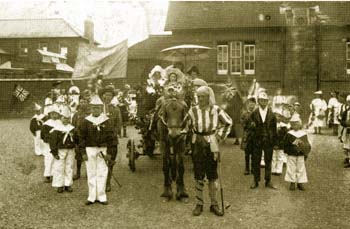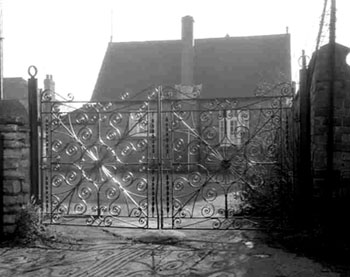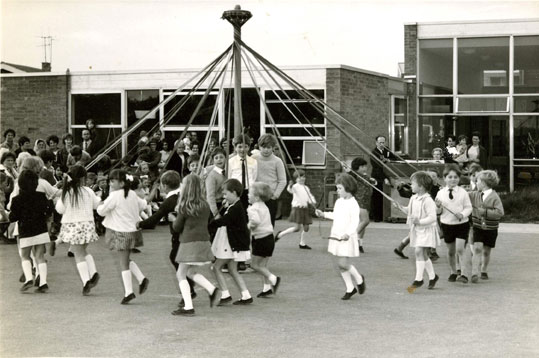New School
THE BIGGEST CHANGE IN EDUCATION
IN YARDLEY GOBION FOR MORE THAN 100 YEARS
FROM 19TH TO 20TH CENTURY SCHOOL

Yardley Gobion School 1874-1968

Thoughts and memories of
Mr J. E. Brooks
It was very strange arriving by train at Wolverton Station and taking the bus ride through the villages to Yardley Gobion. No one I had spoken to had heard of Yardley Gobion so it was a complete unknown quantity. However when I finally arrived I found a small, pretty village with the school set back from the main road behind very high wrought iron gates, surrounded by a high wall, with cottages nearby. The playground was quite small and the school building was brick built with high windows and a bell on the roof. The toilets were “across the yard” and frequently became frozen during the winter months. The interior consisted of three rooms, one for the Infants, one for the Juniors and a fairly small room which we used for everything which included school dinners. These were delivered very early in containers, and were more often than not cold by lunch time. At that time school milk was ‘in being’ and in the winter months that too was frozen solid, the iced milk lifting the cardboard lids well above the bottle tops.
Heating was in the form of two old coke stoves which were very hungry and had to be fed with huge hods of coke. The stoves were surrounded by very large heavy guards which of course had to be moved each time the stoves needed a xtop upx. Some days the stoves were red hot but on other days, when the wind was less favourable they merely smouldered and gave off plenty of fumes.
We had two cloakrooms, one larger than the other and the day came when part of the larger one was converted into four toilet cubicles, two for the girls and two for the boys. There was no provision for the staff and we had to be to become quite skilful in timing our use of them.
At that time the staff consisted of the Head Teacher, an Infant’s teacher and a lady caretaker – cum cleaner and dinner lady. We had no office, no phone,(Mrs Tyrell allowed us to use hers) no television, very little space for P.E. or playtime in bad weather. We had no classroom assistants, but a remedial teacher came for one session a week, otherwise we only had visits from the vicar, the “nit nurse” and occasionally the dentist.
One day the vicar spoke to the children about miracles and how he believed that miracles still happened. A few days later we all believed that too, as a letter arrived telling us that Yardley Gobion was to have a new school. Such excitement as we studied the plans, watched materials arriving and the footings being dug out. Slowly the school began to take shape. What a luxury! Classrooms, corridors, toilets, kitchen, a hall with climbing frames, ropes and lots of equipment. At last we had a staff room, office, stockroom, staff toilets but no phone. This meant that I still had to go out and use a phone in a nearby house. This however was soon rectified because we had a cook to produce our good fresh meals and she needed a phone which I could use.
We had proper cloakroom space and lots of windows at child level and outside space plus the use of a field beyond our boundary.
The new school was officially opened by the Bishop of Peterborough, the children presented him with an enamelled cross, which years later he told me he still had.
The village grew quite rapidly and of course so did the school. More children meant more classrooms needed and of course more staff. We finally qualified for a Deputy Head – Mr Nash.
A further extention was added providing two Infant classrooms and a large area for all kinds of activities. Between the two classrooms, in the dividing wall, there was a fourteen inch door (I do mean 14 inches) which was an unbelievable feature to all those who visited the school. It apparently arose from a misunderstanding between the builder and the architect.
The school became known for several extra curricular activities such as craft, weaving, music, pottery, cane-work, bell ringing and choir. The children performed at concerts, in church, old peoples’ home in the village and on one occasion the bell ringers performed on the local radio and at a wedding in the village. For many years the top juniors were taken on educational visits to Belgium and Holland.
When the last extention was built a small room was designed to take a kiln. When it arrived it was too big to go through the door and for some reason it could not be exchanged for a smaller one. With tongue in cheek I asked for permission to build a kiln room myself. This I did single handed in the evenings, weekends and holidays. Eventually it was put to excellent use.
By the time I left, the staff consisted of the Head Teacher, six teaching staff, one ancillary helper, a secretary and a caretaker. The cook and kitchen staff were made redundant by the closing of the school meals service in small schools.
J. E. Brooks September 2008

New school 1969